Eli Lilly to Cut Price of Insulin by 70%, Cap Insulin Costs at $35 a Month by Susannah Chen and Natalie Sainz for diaTribe.org, 1 March 2023.
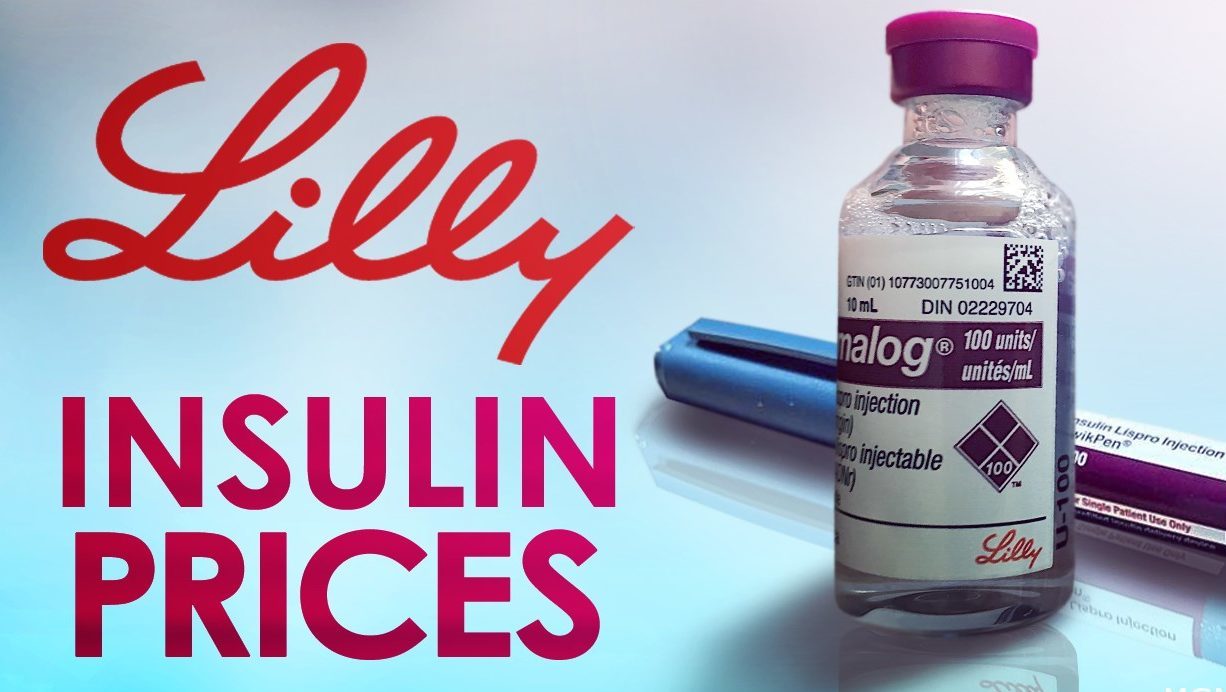 Eli Lilly announced that it will cut the list prices for its most commonly prescribed insulins by 70%. The drug maker will also expand a program that caps out-of-pocket insulin costs for patients at $35 per month.
Eli Lilly announced that it will cut the list prices for its most commonly prescribed insulins by 70%. The drug maker will also expand a program that caps out-of-pocket insulin costs for patients at $35 per month.
On May 1, Lilly will reduce the list price of its non-branded insulin, Insulin Lispro Injection 100 units/mL, to $25 a vial from $82 a vial, making it the lowest list-priced mealtime insulin available on the US market. The company also stated that in the fourth quarter of 2023, it will cut the list prices for its most commonly prescribed insulins, Humalog (insulin lispro injection) 100 units/mL, and Humulin® (insulin human) injection 100 units/mL, by 70%. Humalog currently has a list price of $530 for a five-pack of injection pens and $274 for a 100-unit vial, though Lilly said most people with commercial insurance and Medicare pay no more than $95 a month.
In the same announcement, Lilly announced it will be expanding its Insulin Value Program, which caps patient out-of-pocket costs at a maximum of $35 per month. The program will now also include people with commercial insurance who do not use one of the participating pharmacies. Effective immediately, Lilly will automatically cap out-of-pocket costs at $35 at participating retail pharmacies—about 85% of U.S. pharmacies—for people with commercial insurance using Lilly insulin. People without insurance or those who do not use a participating pharmacy can now download the Lilly Insulin Value Program savings card to receive Lilly insulins for a maximum of $35 a month. The company has now become the first of all insulin drug makers in the U.S. to lower the cost of insulin to $35 per month, a hope that many have pushed for.
“We think that this should be the new standard in America.” —David Ricks, Chair and CEO, Eli Lilly
My question: WHAT TOOK YOU SO LONG??? WHAT ABOUT Novo Nordisk and Sanofi???
Read more: Eli Lilly to Cut Price of Insulin by 70%, Cap Insulin Costs at $35 a Month
Artificial Sweetener Tied to Risk of Heart Attack and Stroke by Will Sullivan for Smithsonianmag.com, 2 March 2023.
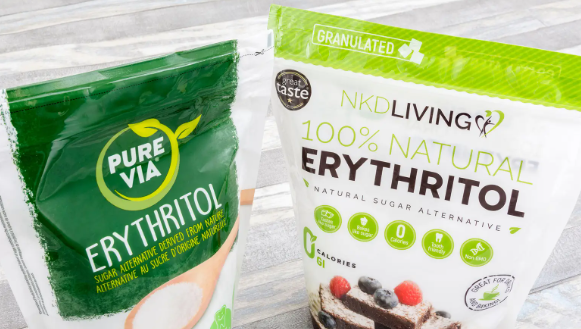 The artificial sweetener erythritol has been linked to a higher risk of heart attacks and strokes, according to a study published Monday in the journal Nature Medicine.
The artificial sweetener erythritol has been linked to a higher risk of heart attacks and strokes, according to a study published Monday in the journal Nature Medicine.
Erythritol is a sugar alcohol found naturally in low amounts in fruits and vegetables but added at much higher levels to processed foods, according to the study. It’s widely used in sugar replacement and reduced sugar products. Due to its ubiquity, some people now have higher-than-normal levels of erythritol in their blood, per New Scientist’s Clare Wilson, which might be leading to an increased risk of blood clots.
“Obviously, more research is needed, but in an abundance of caution, it might make sense to limit erythritol in your diet for now,” Andrew Freeman, a cardiologist at the hospital National Jewish Health who did not contribute to the study
Recently, erythritol has become more common in food products. A 2022 report from NielsenIQ found that sales of foods containing the sweetener grew 43 percent over the previous two years. While artificial sweeteners are generally considered safe by regulatory agencies, little is known about their long-term health effects. “We have work to do on every single one of the artificial sweeteners,” Kimber Stanhope, a research nutritional biologist at the University of California, Davis, who did not contribute to the paper. “It’s ridiculous how understudied they are.”
It’s VERY important to read the labels on any Stevia or Monk Fruit sweeteners. According to an article for CNN.com, “Erythritol is also the largest ingredient by weight in many “natural” stevia and monk fruit products. Because stevia and monk fruit are about 200 to 400 times sweeter than sugar, just a small amount is needed in any product. The bulk of the product is erythritol, which adds the sugar-like crystalline appearance and texture consumers expect.”
This is very true for the product, Truvia: 
However, I use Better Stevia, which does NOT contain Erythritol and Organic Monk Fruit by NOW with no Erythritol. Again, just check the labels before you buy or use these products!
Read more:
Eyecare or iCare? A revolution in the eye screening world by Tim Street for Diabettech.com, 3 March 2023.
iCare Illume is used for eye screening. But perhaps surprisingly, they are able to take photos of the back of your eye without any use of drops (the minimum pupil diameter is apparently 2.5mm). And if that weren’t impressive, the images can be uploaded to their cloud-based AI, reviewed, and returned with analysis within a couple of minutes of completing the eye tests.
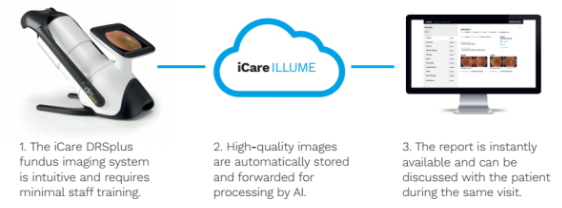 Having a check-to-diagnosis window of less than five minutes, with a clinician present to explain the results would probably benefit a lot of people and make the whole process a lot less scary. To put that time in context, I had the iCare check done on 24th Feb. I had the DECS session on 8th Feb. The letter updating me on the outcome was dated 25th Feb. That’s quite a gap where someone might anxiously wait for the results.
Having a check-to-diagnosis window of less than five minutes, with a clinician present to explain the results would probably benefit a lot of people and make the whole process a lot less scary. To put that time in context, I had the iCare check done on 24th Feb. I had the DECS session on 8th Feb. The letter updating me on the outcome was dated 25th Feb. That’s quite a gap where someone might anxiously wait for the results.
Removing the need for pupil-dilating eyedrops is also a huge benefit, as it makes it far easier for those who need to drive to appointments to get there. Additionally, the size of the machines and the quick time to diagnosis could provide a portable service. As long as there was an internet connection to upload the images to the cloud, then you could get to harder-to-reach people who may fall out of the eye screening process.
Read more:
Android app compatible with smart cap for insulin pens receives FDA clearance and reported by Healio.com/endocrinology, 2 March 2023.
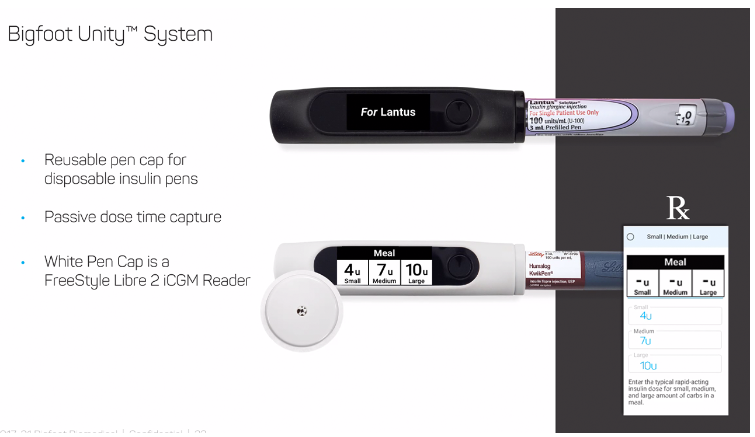 The FDA has granted 510(k) clearance for the launch of an Android mobile app for a connected smart cap for insulin pens. The Bigfoot Unity diabetes management system (Bigfoot Biomedical) was granted 510(k) clearance by the FDA in May 2021 for use by people with diabetes prescribed multiple daily insulin injection therapy. When the system was originally cleared, it was compatible with iOS devices only. This new approval will allow the system to be used by people with Android devices, opening up its use to the 41% of the U.S. population who use those types of devices.
The FDA has granted 510(k) clearance for the launch of an Android mobile app for a connected smart cap for insulin pens. The Bigfoot Unity diabetes management system (Bigfoot Biomedical) was granted 510(k) clearance by the FDA in May 2021 for use by people with diabetes prescribed multiple daily insulin injection therapy. When the system was originally cleared, it was compatible with iOS devices only. This new approval will allow the system to be used by people with Android devices, opening up its use to the 41% of the U.S. population who use those types of devices.
“Most Bigfoot Unity users live with type 2 diabetes and are part of a demographic that is even more likely to use Android devices than the general U.S. population,” Jeffrey Brewer, CEO of Bigfoot Biomedical, said in a press release. “Therefore, as we prepare for our enhanced commercial rollout later this year, this clearance is key to enabling us to expand access to our comprehensive and easy-to-use solution and deliver on our goal to minimize the anxious guesswork involved with insulin dosing.”
The Bigfoot Unity diabetes management system is comprised of smart caps that are integrated with the user’s continuous glucose monitor. The system uses CGM data to display insulin dosing advice on the pen cap for the user. The smart pen caps are compatible with a range of disposable insulin pens for long-active and rapid-acting insulin. The mobile app allows users to input and review healthcare provider therapy recommendations, look at their current glucose range, and receive real-time alerts.
Read more: Android app compatible with smart cap for insulin pens receives FDA clearance
How far are we from fully closed loop? by Tim Street for Diabettech.com, 28 February 2023. From ATTD 2023: While there was a lot of promotion of the new AID (Automated Insulin Delivery) systems available on the market, the interesting areas were in the discussions on clinical trials and various presentations.
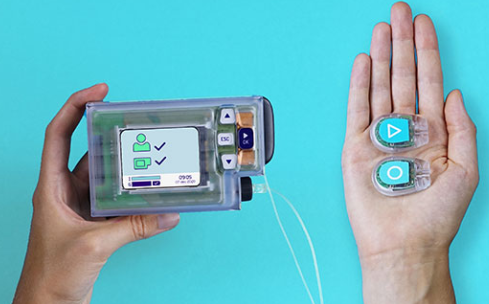 Inreda Diabetic is a small Dutch company founded by Robin Koops. It’s the first approved (it has a CE mark) dual hormone system on the planet and currently has around 125 users in the Netherlands. Robin himself uses it fully closed loop and sees a 93%+ time in range with zero hypos, operating fully closed loop. It’s not the smallest device on the market, but of course, it’s a dual hormone, and currently using the glucagon version you get in the orange box. Whilst the glucagon reservoir currently has to be changed daily, Robin mentioned that they’re testing whether they can get it approved for use for longer periods, which would make the process a whole lot easier.
Inreda Diabetic is a small Dutch company founded by Robin Koops. It’s the first approved (it has a CE mark) dual hormone system on the planet and currently has around 125 users in the Netherlands. Robin himself uses it fully closed loop and sees a 93%+ time in range with zero hypos, operating fully closed loop. It’s not the smallest device on the market, but of course, it’s a dual hormone, and currently using the glucagon version you get in the orange box. Whilst the glucagon reservoir currently has to be changed daily, Robin mentioned that they’re testing whether they can get it approved for use for longer periods, which would make the process a whole lot easier.
 Diabeloop continues to innovate, with the recent announcement of their partnership with EOFlow for the EOPatch pump. But what’s way more interesting is the launch of their new clinical trial that looks at removing the need for intervention around meals in adolescents, in an insulin-only system.
Diabeloop continues to innovate, with the recent announcement of their partnership with EOFlow for the EOPatch pump. But what’s way more interesting is the launch of their new clinical trial that looks at removing the need for intervention around meals in adolescents, in an insulin-only system.
 CamAPS HX is a “full closed loop” algorithm that was trialed in inpatients with type 2. There will be a follow-up study with people with type 1, to understand how effective it is with unannounced meals, similar to Diabeloop.
CamAPS HX is a “full closed loop” algorithm that was trialed in inpatients with type 2. There will be a follow-up study with people with type 1, to understand how effective it is with unannounced meals, similar to Diabeloop.
![]() TypeZero (owned by Dexcom) has been working on their next-generation closed loop system, and once again, they’re looking at a “fully closed loop” or rather, Minimizing Mealtime Management. Referred to as “The Liberty System,” this algorithm is one in which users won’t have to bolus for meals, adjust for exercise, etc.- it is intended to increase time-in-range, ensure you don’t miss meal boluses, and more. It’s being developed for use with Control-IQ in Tandem’s t:slim insulin pump. They’ve undertaken a pilot study in two sites in New Zealand with the primary outcomes being to reduce time above 250 and below 54 among users who find it very tough to manage their type 1. As the image shows, they’ve been very successful, with huge reductions.
TypeZero (owned by Dexcom) has been working on their next-generation closed loop system, and once again, they’re looking at a “fully closed loop” or rather, Minimizing Mealtime Management. Referred to as “The Liberty System,” this algorithm is one in which users won’t have to bolus for meals, adjust for exercise, etc.- it is intended to increase time-in-range, ensure you don’t miss meal boluses, and more. It’s being developed for use with Control-IQ in Tandem’s t:slim insulin pump. They’ve undertaken a pilot study in two sites in New Zealand with the primary outcomes being to reduce time above 250 and below 54 among users who find it very tough to manage their type 1. As the image shows, they’ve been very successful, with huge reductions.
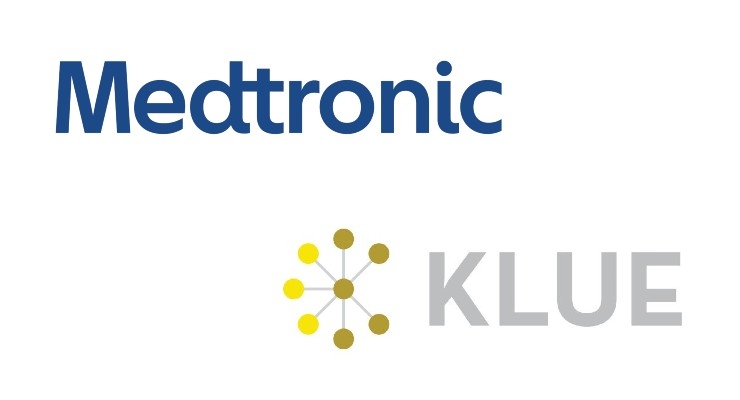 There was also a presentation from Anirban Roy, of Medtronic, who talked about the use of the recently acquired Klue, a watch app, to detect hand gestures when eating and use that information to determine when to mealtime bolus. The initial results showed good post-prandial glucose levels in the n=17 study and align with what we’ve heard Medtronic speak about elsewhere in relation to how they see closed loops working. There were also discussions about the 780G and its use without announcing meals.
There was also a presentation from Anirban Roy, of Medtronic, who talked about the use of the recently acquired Klue, a watch app, to detect hand gestures when eating and use that information to determine when to mealtime bolus. The initial results showed good post-prandial glucose levels in the n=17 study and align with what we’ve heard Medtronic speak about elsewhere in relation to how they see closed loops working. There were also discussions about the 780G and its use without announcing meals.
 Boris Kovatchev: Of course, it wouldn’t be an ATTD with Boris speaking on something important relating to closed-loop systems, and he didn’t fail here either. Boris provided a summary of the various factors that affect a fully closed loop. It breaks down into three areas.
Boris Kovatchev: Of course, it wouldn’t be an ATTD with Boris speaking on something important relating to closed-loop systems, and he didn’t fail here either. Boris provided a summary of the various factors that affect a fully closed loop. It breaks down into three areas.
-
-
-
-
-
-
-
-
- Faster insulins – while general insulin pharmacokinetics are nowhere near the glucose absorption curve, Lyumjev presents possibilities. Other companies are working on even faster insulins as well.
- Mealtime anticipation in algorithms – enabling the system to start to dose insulin ahead of meals based on recognition of when they occur (or as in the Open Source world, scheduling “Eating Soon” periods).
-
- Introducing other hormones – testing has been done with:
- Pramlinatide
- GLP1 receptor agonists
- Glucagon (see Inreda previously)
- SGLT2 inhibitors
-
-
-
-
-
-
The key takeaway is that there are still a lot of people working on fully closed-loop systems. Everyone sees the benefit of making this work and the reduction in diabetes burden that potentially could be obtained, as well as the improvements in clinical outcomes. The future is very much bright, even if it’s not quite clear what it will look like!
Read more: How far are we from fully closed loop? News from ATTD 2023


I have long said that Lilly gets a bad rap over insulin pricing and this recent announcement is more proof. The price of insulin was almost entirely driven by PBM’s. Yet none of the blow back went to PBM’s. I did not see any protestors at the PBM’s, I did not see them at Novo and haven’t seen them targeting the retailers.
So now Lilly removes its insulin from PBM’s makes its own house brand with the very same insulin and what did they get? More protests, more criticism and still their competitors were skating.
So now Lilly reduces insulin prices and what do we see? more criticism from the diabetes community. You should have done it sooner, what were you doing with the profit, etc. Still no criticism, no protests, no demands for Novo to lower prices.
Lets be fair Lilly took the heat and delivered the goods. We need to celebrate each step they took and if you protested at Lilly headquarters and marched into traffic to try to get arrested, well why are you not at Novo headquarters?
Instead of patting yourself on the back and declaring you got them to do it, why are you not thanking the political leadership of the country, who really got it done. Instead of arguing insulin for all, maybe you should learn the economics of the pharma industry.
On a brighter note. I think dialoop is the future of pumps in the next five years.